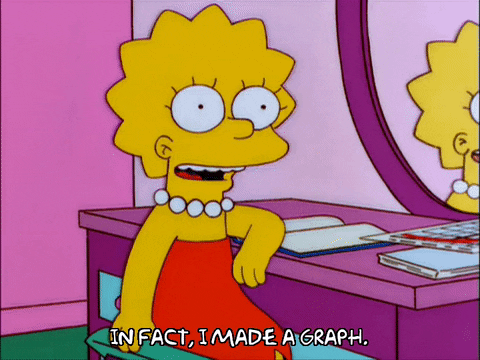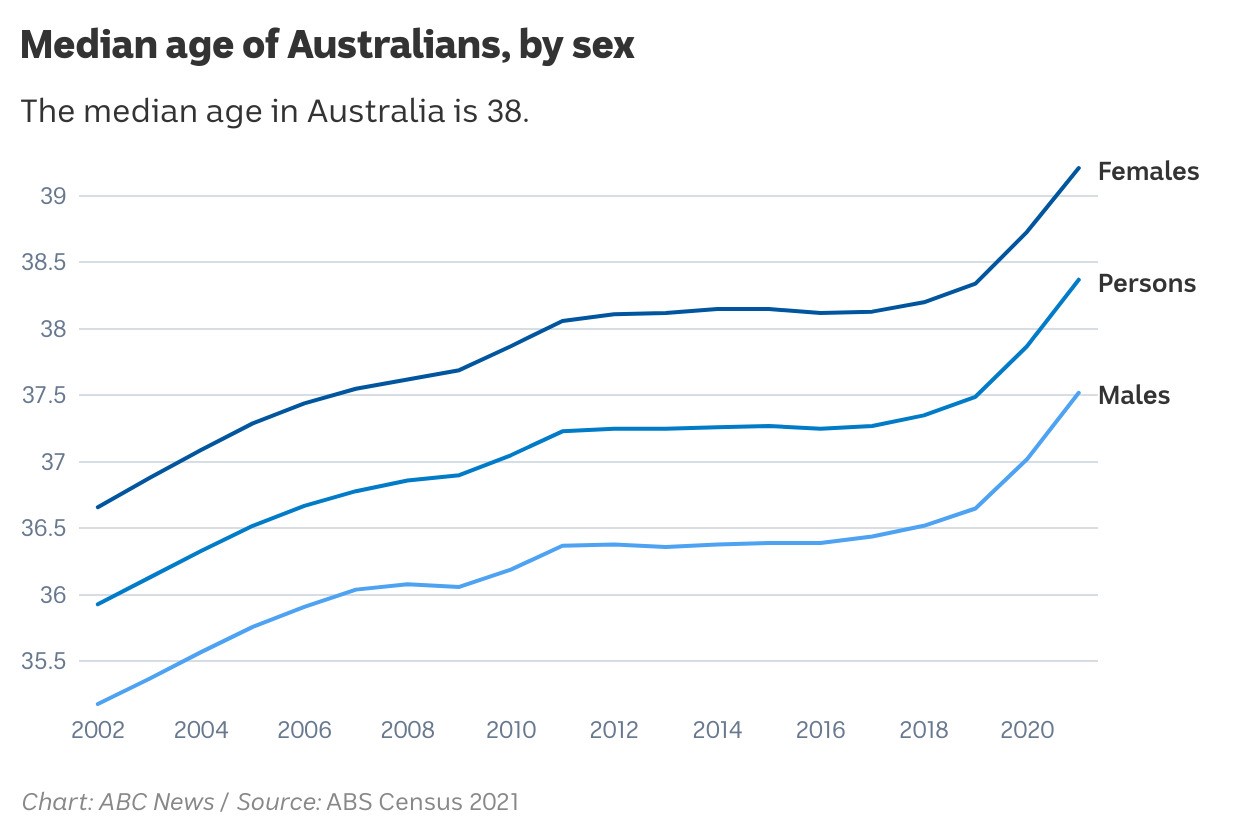The 2021 census results reveal the millennial generation has caught up to baby boomers in becoming the largest generation group in Australia.
Look back on our blog where we unpacked the data.
To leave a comment on the blog, please log in or sign up for an ABC account.
Live updates
By Jessica Riga
We'll wrap up our live coverage here
Thanks for joining us today as we geeked out over the 2021 Census results!

We'll continue to unpack the data throughout the week here on the ABC News website and on our app.
See you next time!
By Jessica Riga
Compared to five years ago, Australia looks vastly different
It's bigger and more diverse than ever, according to the first batch of data from the 2021 Census.
There are as many millennials as baby boomers, there are more than one million single-parent families and there has been an "unexpected" move to high-rise living.
Angelica Silva and Nicholas McElroy walk you through the highlights from the latest Census in this story below.
By Jessica Riga
Just joining us now?
Here's a quick recap of the key findings from the 2021 Census data to get you up to speed.
By Jessica Riga
The ACT is holding onto the title of having the fastest growing population
The ACT has the nation's fastest growing population for a second census in a row, with 454,000 people counted in the latest poll.
Data released today shows Canberra's population has increased by 50 per cent in 20 years, and by 57,000 since the 2016 census.
Nepali is now one of the top five languages in Canberra, as Australia's Nepalese population more than doubled since the last census.
By Jessica Riga
The Gold Coast is one of the most expensive places to rent in Australia
Figures out today from the ABS put the tourist capital's rent at $85 more than Queensland's median weekly rent and $75 more than the national median.
They also show more than 40 per cent of people renting on the Gold Coast are considered to be suffering from rental stress, meaning 30 per cent or more of their weekly income is being paid in rent.
More people are living on the Gold Coast too, according to the latest figures.
You can continue reading this story by Kimberley Bernard below to get a snapshot of how the Glitter Strip has changed in five years.
By Jessica Riga
Western Australia has actually bucked a national trend
WA's population has bucked the national trend, with a falling share of millennials compared to baby boomers.
And even though millennials still make up a greater proportion of the state than the older cohort, the state's average age is increasing.
You can read more on this story from Keane Bourke below.
By Emily Sakzewski
Taking a look at family composition
For the first time, the Census has recorded more than 1 million one-parent families, and 80 per cent of those parents were female.
The data also showed:
- 46 per cent of Australians over the age of 15 were in a registered marriage;
- 11 per cent were in a de facto marriage;
- 42 per cent were not married;
- 3 per cent were separated;
- 9 per cent were divorced;
- 5 per cent were widowed.
By Emily Sakzewski
There are over 1 million vacant homes across Australia
As we said before, the proportion of people who own their own home outright has dropped to 30 per cent, down from 40 per cent in 1996.
In the same time period, households with a mortgage increased from 26 to 35 per cent.
But one figure that has come out of the data caught the eye of demographer Dr Liz Allen from the Australian National University is the number of vacant homes in Australia.
"Out of all of the home ownership and the living metrics that we're seeing in this census, one stands out the most to me," she told AM.
"And that is the fact that we have one million vacant homes across this country.
"Given what we know about housing affordability and homelessness, that is a terrible reflection on policy."
By Jessica Riga
Now for something a little different...
When Census night 2021 rolled around, Pirate Priestess Angela Carter and her husband Captain Colin 'Cupcakes' Carter followed an instruction from their leader and selected the 'No religion' option where the nationwide survey asked respondents about their religious affiliations.
Yet, the Carters were ministers and owners at the only recognised church of their faith in Australia.
The couple are among a growing number of Australians who consider themselves Pastafarians, or members of the Church of the Flying Spaghetti Monster.

Their faith was seen by some as a satire mocking other religions, but members of the largely online community said it espoused values of respect and common decency.
You can continue reading this story by Matt Neal below.
By Emily Sakzewski
Taking a look at ancestry and country of birth
The top responses on ancestry in 2021 were English and Australian.
Other top responses include Irish, Scottish and Chinese, all of which increased since 2016.
Now looking at country of birth, and other than Australia the top response is England. That's followed by India, China, New Zealand and Philippines.
By Jessica Riga
Australians are becoming less religious
For the first time, fewer than half of Australians identified as Christian, though Christianity remained the nation's most common religion followed by Islam.
By Shiloh Payne
The percentage of Australians reporting not religious affiliation grows
Here's another look at the statistics around religion in the census.
There is now 38.9 per cent of the Australian population who have reported no religious affiliation in the census.
This has grown from 30.1 per cent in 2016.
Christianity remains the most common religion with 43.9 per cent of the population identifying as Christian, a decrease from 52.1 per cent in the 2016 Census.
The top 5 religions outside of Christianity are Islam, Hinduism, Buddhism, Sikhism and Judaism.
There's also been an uptick in people answering the religion question, which is voluntary, in the census.
It went from 91 per cent in 2016 to 93 per cent in 2021.
By Shiloh Payne
Mental health is the most reported long-term illness
As we mentioned earlier, the 2021 Census results show more than 8 million people reported having a long-term health condition.
Mental health was the most reported long-term health condition, at 2.2 million.
People aged 25-29 were the group with the highest reporting of mental health conditions.

By Shiloh Payne
What are the key findings of the 2021 Census?
From demographic shifts to migration, religion and the impacts of the pandemic, here's what ABC statisticians David Gruen and Teresa Dickinson say are the key results of the census.
By Emily Sakzewski
The pandemic saw a shift in state and territory populations
This chart shows the change to state and territory populations from March 2017 to December 2021.
Victoria and NSW saw a reduction to their population during 2020, likely as a result of the pandemic.
Other states such as Queensland, WA and SA saw less growth to their populations.
By Shiloh Payne
What about Gen X?
Today's census data has focused heavily on the millennial generation catching up to the baby boomers, but but what about the generation in between?
Generation X, which the ABS classifies as people aged between 40 and 54, makes up the third biggest population in Australia at 19.3 per cent.
Here's a look at all of the populations by generation:
- Baby boomers (55-74 years) — 21.5 per cent
- Millennials (25-39 years) — 21.5 per cent
- Generation X (40-54 years) — 19.3 per cent
- Generation Z (10-24 years) — 18.2 per cent
- Generation Aplha (0-9 years) — 12.0 per cent
- Interwar (75 years and over) — 7.5 per cent
The 2021 Census counted 25,422,788 people in Australia, an increase of 8.6 per cent since the 2016 Census.
By Emily Sakzewski
Australia's population change over the past 10 years
Some key stats:
- Australia’s population was 25,766,605 at 31 December, 2021
- The quarterly growth was 63,400 people (0.2%)
- The annual growth was 128,000 people (0.5%)
- Annual natural increase was 138,500 and net overseas migration was -3,600.
By Emily Sakzewski
What is the median age?
I think it would be a good idea to grasp what the median age of Australia is looking like, considering COVID has been slowly eroding the Boomers+ amongst us.
- Amy
Hi Amy, the median age is 38 and is slightly higher for women.

By Shiloh Payne
Lockdown and travel restrictions influenced where people completed the census
Data from the census shows the response rate increased from 95.1 per cent in 2016 to 96.1 per cent.
The percentage of households completing the census online increased to nearly four out of five.
Lockdowns meant more families and households were together on census night.
By Shiloh Payne
The number of Jedi in Australia has gone down
Statistician Teresa Dickinson has outlined a few things she thought were "unusual" in this Census.
"I thought it was unusual that there is now half a million of us living in high-rise flats, higher than nine storeys. That wasn't something I expected to see," she said.
"While I knew that we are a nation of drivers, the very high proportion of households that have at least one motor vehicle was a surprise to me too, and the fact that the number of Jedi have gone down, that was a surprise too.







